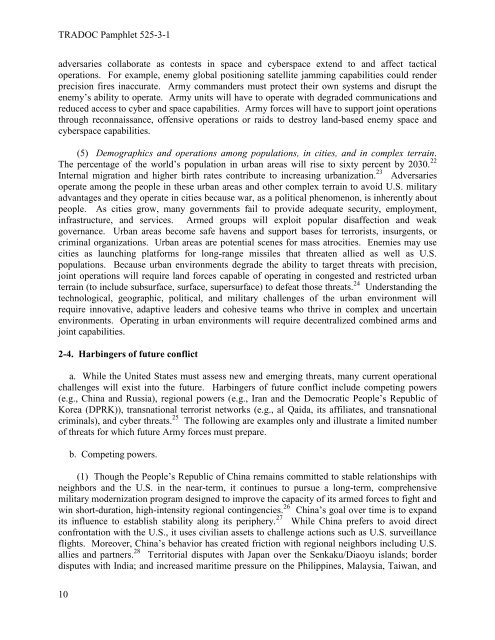TP525-3-1
TP525-3-1
TP525-3-1
You also want an ePaper? Increase the reach of your titles
YUMPU automatically turns print PDFs into web optimized ePapers that Google loves.
TRADOC Pamphlet 525-3-1<br />
adversaries collaborate as contests in space and cyberspace extend to and affect tactical<br />
operations. For example, enemy global positioning satellite jamming capabilities could render<br />
precision fires inaccurate. Army commanders must protect their own systems and disrupt the<br />
enemy’s ability to operate. Army units will have to operate with degraded communications and<br />
reduced access to cyber and space capabilities. Army forces will have to support joint operations<br />
through reconnaissance, offensive operations or raids to destroy land-based enemy space and<br />
cyberspace capabilities.<br />
(5) Demographics and operations among populations, in cities, and in complex terrain.<br />
The percentage of the world’s population in urban areas will rise to sixty percent by 2030. 22<br />
Internal migration and higher birth rates contribute to increasing urbanization. 23 Adversaries<br />
operate among the people in these urban areas and other complex terrain to avoid U.S. military<br />
advantages and they operate in cities because war, as a political phenomenon, is inherently about<br />
people. As cities grow, many governments fail to provide adequate security, employment,<br />
infrastructure, and services. Armed groups will exploit popular disaffection and weak<br />
governance. Urban areas become safe havens and support bases for terrorists, insurgents, or<br />
criminal organizations. Urban areas are potential scenes for mass atrocities. Enemies may use<br />
cities as launching platforms for long-range missiles that threaten allied as well as U.S.<br />
populations. Because urban environments degrade the ability to target threats with precision,<br />
joint operations will require land forces capable of operating in congested and restricted urban<br />
terrain (to include subsurface, surface, supersurface) to defeat those threats. 24 Understanding the<br />
technological, geographic, political, and military challenges of the urban environment will<br />
require innovative, adaptive leaders and cohesive teams who thrive in complex and uncertain<br />
environments. Operating in urban environments will require decentralized combined arms and<br />
joint capabilities.<br />
2-4. Harbingers of future conflict<br />
a. While the United States must assess new and emerging threats, many current operational<br />
challenges will exist into the future. Harbingers of future conflict include competing powers<br />
(e.g., China and Russia), regional powers (e.g., Iran and the Democratic People’s Republic of<br />
Korea (DPRK)), transnational terrorist networks (e.g., al Qaida, its affiliates, and transnational<br />
criminals), and cyber threats. 25 The following are examples only and illustrate a limited number<br />
of threats for which future Army forces must prepare.<br />
b. Competing powers.<br />
(1) Though the People’s Republic of China remains committed to stable relationships with<br />
neighbors and the U.S. in the near-term, it continues to pursue a long-term, comprehensive<br />
military modernization program designed to improve the capacity of its armed forces to fight and<br />
win short-duration, high-intensity regional contingencies. 26 China’s goal over time is to expand<br />
its influence to establish stability along its periphery. 27 While China prefers to avoid direct<br />
confrontation with the U.S., it uses civilian assets to challenge actions such as U.S. surveillance<br />
flights. Moreover, China’s behavior has created friction with regional neighbors including U.S.<br />
allies and partners. 28 Territorial disputes with Japan over the Senkaku/Diaoyu islands; border<br />
disputes with India; and increased maritime pressure on the Philippines, Malaysia, Taiwan, and<br />
10


